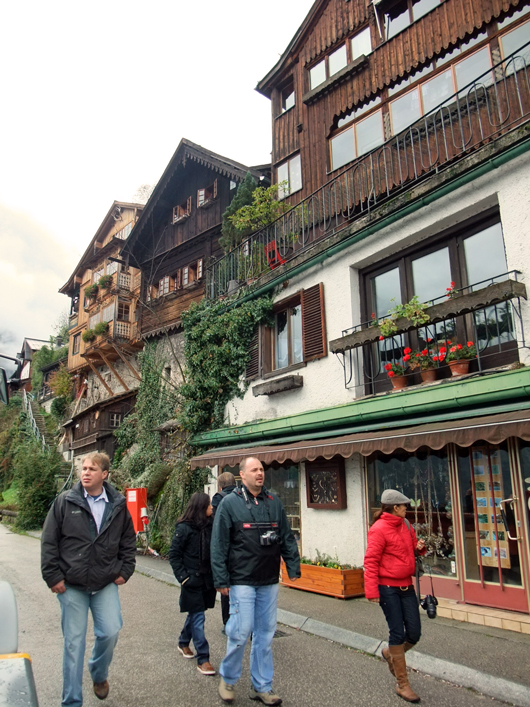< a bison looking
back: Madeleine, 20000
years ago >
We have seen until now the glacial epoch fine arts that happened in Europe.
This time, we consider the meaning of the glacial arts.

< transition of Venus statue: left side, Czech, about30000 years ago.
right side, Germany, 15000 years ago. >
The feature of glacial epoch fine arts
1.
What
was drawn and sculpted
Although horse,
bison and deer were drawn plenty, fish and reindeer that could be caught easily
were not drawn little. A natural scene also was not drawn. The mammoth that
could be caught rarely, the pregnant female, and the animal of one pair of male
and female animals are conspicuous in there. Although the scene where peoples
hunted animals were not drawn, an animal in which bow and spear were stuck, and
something like trap or cage were drawn.
Male design was
simple thing of two points by the circle and another was symbolization of
genitals. As for female design, shape of a body was emphasized, and relief in
cave and sculpture was only female images. Other sculptures of whole body were
half beast and half man or personalized thing.
Else, There are hand
paintings that lacked any fingers and simple and various figures. It seems that
the numbers were recorded by the condition of lacked finger in hand paintings,
and engraved lines recorded the calendar too. Some simple figures were broadly
common.
< transition of cave pictures: lift side, hyena, France,32000 years ago.
right side, bison, Spain,14500 years ago >
2.
Technique of drawing and sculpting
The pictorial expression began from the monochromatic outline of a
line, and progressed to the line drawing with inflection.
Subsequently, the
details like hair were drawn additionally, the contrasting density was
expressed in connection with widely painting, and then it progressed to polychromatic
drawing from 2-color drawing.
Although most
animal images were drawn by the side view, only the hoof was drawn by the front
view. This will be because the hoof that shows health condition was thought as
important. This brings my mind back to the mural painting of ancient Egypt.
Paints were
devised very much and obtained the multiple colors that mixes various minerals
with oil and fats, and is liquid. In Altamira, the charcoal that obtains black
was selected carefully by the wooden kind. In Lascaux, the bone of the animal
was burned at 400 degrees, and calcite was mixed with it, and also it became
hot at 1000 times, and used it.
3. others
There is many cave painting in the inner part of
the caves that not get any
sunlight. There is it in the entrance used as the place of
the life. Moreover, the mural painting is drawn also on the cave in which it
does not live. The animal of the cave paintings was almost painted-over picture, and probably, the
peoples in those days didn’t put importance on good-looking picture.
In 20,000
years, although cave painting came to have a rich expression, Venus statue of end-stage half became a simple design.
Although this Venus statue image had a
commonality by the side
view, it reflected the diversity of the region.
< hand
painting in cave: France ,32000 years ago. Flute: made of bone, German, about
35000 years ago. >
What changed?
1.
have magical
thinking : They expressed things that they
wished and accept a value through paintings and statue, and people present
their wishes to it.
2.
manipulated number and technology : They
began to record a notation or a
calendar by combining. Technology was developed similarly.
3.
created and place importance on formality : Although fine arts change with the times
and reflect the diversity of the
region, have a commonality.
4. cherished these with groups : They taught pictures technique,
left cave painting to the specific person, and occasionally performed the
festival.
5.
moved broadly and trafficked with the
long distance : We can guess from a stone
tool, the similarity of design with fine arts, and stone tool material.
< People lived by rock shadow at 30,000 years ago >
What happened to human
beings?
Cro-Magnon man began half-settled life
with the group more than a family in arctic cold, in and around cave.
Two reasons
made it possible was that they had to hunt much reindeer that do seasonal
migration by group, and coldness enabled preservation of a lot of meat.
If it is hot, meat
will rot. If it is cold, a reindeer will disappear and their heavy winter
clothing becomes useless.
They were able to
make the dress that matches their body by the needle made from a bone.
The intercommunion with a family, a group, and other groups influenced
each other, and greatly developed language, child-rearing, and technology. Furthermore,
culture and a sense of values (religion, art) were produced.
Next time, we
will look at decline period of glacial epoch fine arts.































